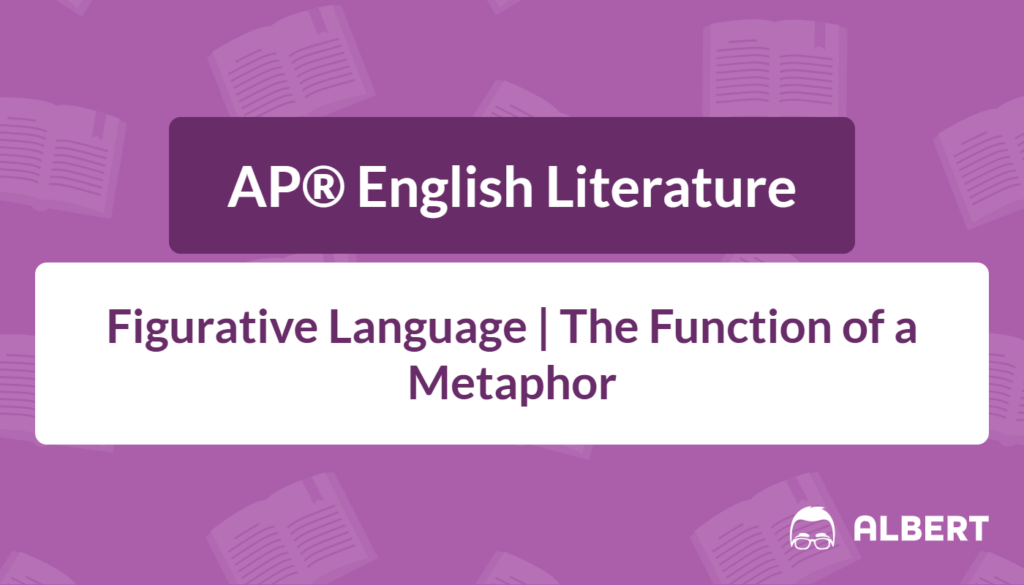What We Review
A Quick Overview of Figurative Language
Figurative language plays a crucial role in bringing literary works to life. While similes, personification, and hyperbole all have their uses, understanding the metaphor in literature can be especially powerful. Metaphors seem simple on the surface, yet they enrich stories and poems by creating vivid comparisons that go beyond literal meaning. This post takes a closer look at what metaphors are, why they matter, and how to analyze them for deeper understanding on the AP® Literature exam.
What a Metaphor Really Is
A metaphor compares two unlike things without using “like” or “as.” This technique helps writers convey complex ideas and emotions in a concise, imaginative way. By contrast, similes use “like” or “as” to make the comparison (for example, “Her smile was like sunshine”). Metaphors, however, skip such words and directly state that one thing is another, as in “Her smile was sunshine.”
Metaphors create strong imagery because they encourage readers to interpret layers of meaning. To define metaphor in literature, think of it as a bridge that connects everyday reality to a more symbolic vision. Shakespeare calls life “a walking shadow,” which suggests that existence is temporary and insubstantial without literally comparing a human being to an actual shadow using “like” or “as.”

The Function of a Metaphor
Metaphors accomplish several important tasks in literature. First, they add emotional and sensory depth. When characters or events are compared to something unexpected, readers tune in on a more personal level. Second, they provide clarity by condensing complex ideas into a single, striking image. Finally, metaphors set the tone of a passage, guiding readers toward a certain mood or feeling.
In To Kill a Mockingbird, Harper Lee uses metaphor to deepen readers’ understanding of moral courage. When Atticus tells Scout, “Courage is not a man with a gun in his hand. It’s when you know you’re licked before you begin but you begin anyway and you see it through no matter what,” he is crafting a metaphor that redefines bravery.
Step-by-step, notice how this metaphor works:
- First, identify the figurative comparison: courage is not equated with physical strength or violence (a man with a gun) but with inner resolve in the face of certain defeat.
- Next, consider what this reveals about the character: Atticus’s view of bravery is intellectual and moral, which distinguishes him from others in Maycomb and sets the tone for Scout’s own growth.
- Finally, connect this to a wider theme: the metaphor reframes heroism, reinforcing the novel’s central theme that real courage often comes in the form of quiet resistance to injustice.
By understanding courage through Atticus’s metaphor, readers are invited to reflect on what it means to act honorably, even when success seems impossible.
Extended Metaphor: A Closer Look
A simple metaphor states one idea briefly, but an extended metaphor stretches the comparison across several lines or even an entire literary work. This creates a broader framework that shapes meaning through repetition and imagery. The extended metaphor definition emphasizes the continued application of one comparison throughout a poem, play, or passage.
In poetry, extended metaphors frequently appear to illustrate abstract concepts. Consider William Shakespeare’s “Sonnet 18,” where the poet compares their beloved to a summer’s day. Although the poem does not explicitly say “you are summer,” it repeatedly parallels the beloved’s qualities and the best features of summer, such as warmth and vibrancy.
To see how an extended metaphor unfolds step by step:
- Begin by identifying the base comparison: in this case, the beloved is compared to a day in summer.
- Look for clues throughout the poem: references to warmth, blossoming, or even the transience of seasons.
- Notice how each successive line builds on that initial concept: Shakespeare furthers the idea by contrasting the beloved’s eternal beauty with summer’s tendency to fade.
This continuous thread shapes the poem’s meaning. Instead of feeling like a quick aside, the metaphor forms the poem’s core statement about transcendent love, providing readers with a unifying lens through which to interpret each line.
Seeing Metaphors in Action
Spotting metaphors often starts with looking for direct substitutions. The writer might label an emotion, idea, or character with a term usually reserved for something else. Some metaphors are obvious, like describing a person as “a rock” for their reliability. Others are subtle and require close reading.
Lorraine Hansberry’s A Raisin in the Sun, the title itself is a metaphor drawn from Langston Hughes’s poem “Harlem.” The “raisin in the sun” metaphorically represents deferred dreams and the potential bitterness or decay that comes from unrealized aspirations. Throughout the play, the Younger family’s struggles reflect the risk that their hopes and ambitions might wither away under social and economic pressures, much like a raisin shriveling under the harsh sun.
For analysis:
- Identify the literal image: a raisin drying and shrinking in the sun.
- Interpret how the deferred dreams of the Younger family parallel the drying raisin: hopes that risk losing vitality if postponed too long.
- Tie this metaphor to larger themes of racial discrimination, economic hardship, and the resilience of hope.
Slowly linking these steps helps uncover deeper layers of meaning and relates them to the play’s central message about the costs and endurance of dreams.
How Metaphors Enhance Poetry
Poetry often uses concise language, which means figurative devices like metaphor in poetry become essential. Poems rely on comparison to convey complex emotions, enabling readers to experience multiple interpretations from a short set of lines. Because poems are typically structured with meter or rhyme, a well-placed metaphor can resonate more powerfully by aligning with rhythmic patterns or emphasizing certain words through line breaks.
It helps to remember that metaphors may shift the focus from one set of ideas to another. For instance, in an elegy, a poet might compare memories of a lost loved one to imprints on wet sand—an image that captures both presence and impermanence. Examining the lines that follow this comparison reveals how the poet develops the metaphor, possibly including themes of time, change, or the fragility of human life.
Identifying Metaphors and Interpreting Their Meaning
While reading, watch for moments when an author uses figurative comparisons. Authors sometimes hint at metaphors through descriptive language that doesn’t quite match reality, such as describing the wind as a whispering friend. Readers can ask:
- Which qualities from the original image are emphasized?
- How do these qualities connect to the story’s conflicts or character motivations?
- Is the metaphor repeated or expanded later in the text?
A strong example appears in George Orwell’s 1984. The omnipresent image of “Big Brother” is more than just a character—it functions as a metaphor for oppressive government surveillance and loss of personal freedom. “Big Brother” symbolizes an all-seeing, controlling force that invades every aspect of life, emphasizing the pervasive paranoia and helplessness experienced by the protagonist and society at large. This metaphor recurs throughout the novel in posters, telescreens, and slogans, reinforcing the themes of control, manipulation, and the destruction of individuality.
Analyzing this metaphor involves:
- Identifying the literal image: an all-seeing, protective brother figure.
- Recognizing the ironic contrast between the comforting name “Big Brother” and the harsh reality of authoritarian control.
- Connecting the metaphor to the characters’ struggles against dehumanization and the erasure of truth.
By tracing the metaphor of “Big Brother” throughout 1984, readers gain insight into the novel’s warnings about totalitarianism and the power dynamics between the individual and the state.
Putting It All Together
Understanding a metaphor in literature involves looking beyond the surface to see how writers link concrete details to deeper truths. Sometimes, a metaphor’s purpose is to heighten emotion, while other times it structures the entire narrative and reveals central themes. When studying for the AP® Literature exam, consider these points:
- Pay attention to repeated images or words that hint at a metaphor.
- Analyze how the comparison relates to a character’s emotional state or the text’s broader concerns.
- Notice if an extended metaphor carries the story or poem’s main message.
Small observations often lead to the most meaningful insights. Metaphors shape worlds, capture complex feelings, and transform simple descriptions into unforgettable images. By slowly unpacking each step, readers can develop a richer understanding of the text and confidently discuss these comparisons in essays or discussions.
Quick Reference Vocabulary Chart
| Term | Definition or Key Feature |
| Metaphor | A figure of speech comparing two unlike things without using “like” or “as.” |
| Simile | A comparison that uses “like” or “as” to connect two different things. |
| Extended Metaphor | A metaphor that continues throughout a passage, poem, or entire literary work. |
| Figurative Language | Creative word usage, including metaphors, similes, and personification. |
| Symbol | An object, character, or setting that stands for a broader idea or concept. |
| Imagery | Language that appeals to the senses to form mental pictures or evoke emotions. |
| Theme | The central insight, idea, or message explored in a literary work. |
Final Thoughts
Metaphors are more than decorative phrases. They guide readers to see people, places, and ideas in fresh, surprising ways. Whether it’s a short remark that brightens a character’s personality or an extended metaphor example that anchors a poem, these comparisons shed light on the power of language. By mastering what is metaphor in literature and learning to spot it in prose and poetry, students can uncover meaning that might remain hidden at first glance—and, in turn, provide thoughtful analysis on the AP® Literature exam.
Sharpen Your Skills for AP® English Literature and Composition
Are you preparing for the AP® English Literature and Composition test? We’ve got you covered! Try our review articles designed to help you confidently tackle real-world AP® English Literature and Composition problems. You’ll find everything you need to succeed, from quick tips to detailed strategies. Start exploring now!
- AP® English Literature: Figurative v. Literal Language
- AP® English Literature: Word Choice
- AP® English Literature: Symbolism in Literature
- AP® English Literature: Imagery in Literature
- AP® English Literature: Simile in Literature
- AP® English Literature: Personification in Literature
- AP® English Literature: Allusion in Literature
Need help preparing for your AP® English Literature and Composition exam?
Albert has hundreds of AP® English Literature and Composition practice questions, free response, and full-length practice tests to try out.








